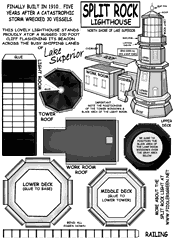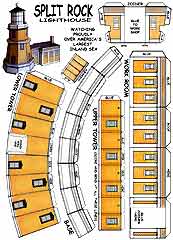

Split Rock Lighthouse

Northern Minnesota is famous for its many beautiful places, such as the Boundary Waters Canoe Area, Voyageurs National Park, the Lake of the Woods country, and the rugged Lake Superior coastline.
It is a vast, wild territory that, despite a few roads and towns, has changed little since the first French "runners of the woods" paddled their birch-bark canoes across the Great Lakes in the 17th century to begin exploring.
What People Say...
Chip was proud of this series, and rightly so. This is a fine model. The only changes I made was in using cereal box cardboard to reinforce the floors. Everything fits and a beginner could make this one easily. Beautiful model. - Alan Wheeler
Split Rock Lighthouse

Northern Minnesota is famous for its many beautiful places, such as the Boundary Waters Canoe Area, Voyageurs National Park, the Lake of the Woods country, and the rugged Lake Superior coastline.
It is a vast, wild territory that, despite a few roads and towns, has changed little since the first French "runners of the woods" paddled their birch-bark canoes across the Great Lakes in the 17th century to begin exploring.
Its a landscape in which nature rules supreme, a place where fall storms roar in from the Arctic every October and spring snows linger into may. It's where the black bears, grow to legendary size and the gray wolves go running over the frozen lakes beneath the shimmering northern lights.
Residents and visitors alike have observed that nowhere in all that fabled north country is there, a site more lovely than Split Rock Light.
The Minnesota coastline along western Lake Superior runs from the Thunder Bay region on the north to the port city of Duluth on the South. For the most part, it is a heavily forested coastline, with rolling hills, steep ridges, and frequent rock outcrops.
Although the lake waters are deep on the northern coast-ranging to 129 feet near Grand Portage, Minnesota, and isle Royale, Michigan-they become quite shallow near the lake's western coast in Minnesota-down to 20 feet or less. For this reason, a series of coastal lights was needed to warn vessels. Since the beginning of its modern exploration, Lake Superior-the largest of the Great Lakes at more than 350 Miles long and covering 31,700 square miles-has seen a great amount of commercial traffic. Products such as timber, fish, wheat, corn, coal. iron ore, copper, and automobiles have traveled along its shipping lanes. The need for coastal lighthouses became more pressing over time.
"GOOD FOR A LIGHTHOUSE, wrote surveyor Thomas Clark in his journal while mapping the rugged coastline between Duluth and Beaver Bay in 1854. A month before Clark's visit, the signing of a treaty with the Ojibway had opened up the North Shore to nonIndian settlement. In the summer of 1856 the Reverend James Peet, an early missionary at the head of the lakes, took refuge in a nearby cove when a northeast squall made the water too rough for his tiny sailboat. He was returning to Superior from Beaver Bay, a settlement scarcely seven weeks old.
Like many lighthouses on the Great Lakes, the lighthouse at Split Rock was built fairly late-1910. Part of the impetus for placing a station at Split Rock was that the schooner-barge Madeira was lost and the steamer William Edenborn, which had been towing the Madeira, wrecked near the site during a terrible storm in November 1905- a storm that sank or damaged more than 30 other boats on Lake Superior as well.
 The Split Rock
Light was constructed on about seven acres of land roughly 20 miles
northeast of Two Harbors, where a lighthouse had been established
in 1892 to guide iron-ore freighters and other commercial vessels
in the busy Minnesota channel. The actual task of raising the Split
Rock Lighthouse was quite difficult, as building materials had to
be transported by boat from Duluth, nearly 50 miles to the south,
and then hauled up to the top of the 120-foot Split Rock cliffs.
The tower and residence cost over $70,000 in materials and labor,
the equivalent of several million dollars in today's currency.
The Split Rock
Light was constructed on about seven acres of land roughly 20 miles
northeast of Two Harbors, where a lighthouse had been established
in 1892 to guide iron-ore freighters and other commercial vessels
in the busy Minnesota channel. The actual task of raising the Split
Rock Lighthouse was quite difficult, as building materials had to
be transported by boat from Duluth, nearly 50 miles to the south,
and then hauled up to the top of the 120-foot Split Rock cliffs.
The tower and residence cost over $70,000 in materials and labor,
the equivalent of several million dollars in today's currency.
One of the most interesting aspects of the Split Rock Light house was the clockwork machinery that turned the giant Fresnel lens and caused the light to flash. Its inner workings resembled those of a grandfather clock. A cable attached the turntable and various gears to a 200-pound weight, which was slowly lowered down the center of the lighthouse tower.
Every few hours, the lighthouse keeper had to use a hand device to winch the weight back to the ceiling so that it could continue to move the heavy lens apparatus. The lens produced a beam that could be seen from 20 miles out on the lake, and remains in place to this day. There is no telling how many lives it saved during its almost one century of service.
 When
the engineers of the Lighthouse Board selected the site for the
new station half a century later they agreed with Clark's judgment
about the rocky promontory, which was known locally as Stony Point.
Although "Split Rock" is the name by which the lighthouse
became known, the origin of the term is shrouded in speculation.
Canadian officer Henry W. Bayfield, who surveyed the lake in 1825,
used the name to refer to the river located two and a half miles
southwest of the lighthouse. It remains unclear whether the name
derived from the geological fact of the river splitting the rock
canyon through which it passes or simply from the appearance of
the rock itself-the white streaks of anorthosite running through
the black igneous diabase seem, in fact, to "split the rock."
Other theorists derive the name from cliffs northeast of the river,
one or both of which have been variously known as Split Rock Point
because, when viewed from the water, they look like one rock that
is split apart.
When
the engineers of the Lighthouse Board selected the site for the
new station half a century later they agreed with Clark's judgment
about the rocky promontory, which was known locally as Stony Point.
Although "Split Rock" is the name by which the lighthouse
became known, the origin of the term is shrouded in speculation.
Canadian officer Henry W. Bayfield, who surveyed the lake in 1825,
used the name to refer to the river located two and a half miles
southwest of the lighthouse. It remains unclear whether the name
derived from the geological fact of the river splitting the rock
canyon through which it passes or simply from the appearance of
the rock itself-the white streaks of anorthosite running through
the black igneous diabase seem, in fact, to "split the rock."
Other theorists derive the name from cliffs northeast of the river,
one or both of which have been variously known as Split Rock Point
because, when viewed from the water, they look like one rock that
is split apart.
In any event, the name came to be applied to the lighthouse when
the ship owners who lobbied in Washington for the establishment of
a light in the region proposed that it be built "in the vicinity
of Split Rock, Minnesota, preferably on Corundum Point." Because
it was erroneously believed that valuable abrasive minerals existed
at the latter, the site chosen for the light station was on Stony
Point, farther to the northeast. The name Split Rock stuck, however,
and came to be applied to the entire region between the lighthouse
and the river.
When construction boats arrived in May 1909, the first job was to
find a way to raise the building materials to the top of the cliff.
"The initial undertaking was to land and install a powerful
hoisting engine, 11 recalled engineer Ralph Russell Tinkham. "This
was landed from a barge on the rocky shore of the small cove at
the south end of the cliff where a rough steep slope extends from
the shore line up behind the cliff to its summit." The men
cut a swath through the dense woods, and although the vital steam
engine and boiler tipped over halfway up the slope, it eventually
reached the top. "Mounted on skids this hoisting engine was
made to pull itself up the steep slope with lines and tackle attached
to trees on the slope above it," wrote Tinkham.
Once the hoisting engine was in place, "installed and housed near the cliff edge north of the corundum outcrop," Tinkham continued, the workers devised a method for hauling all their supplies up to the lighthouse site. "Using an improvised A-frame and tackle at the edge of the vertical cliff," the men hoisted "the components of a heavy duty stiff legged derrick . . . from a barge moored to ring bolts anchored in the rock cliff at lake level, a hundred feet below the ground level of the station site. This derrick was then erected near the top edge of the cliff, securely anchored to the rock surface, and thereafter was used throughout the construction of the station for hoisting all materials, equipment, and supplies from the barges, or the cruiser, including the lifting or lowering of personnel in a box crate, called a skip."





